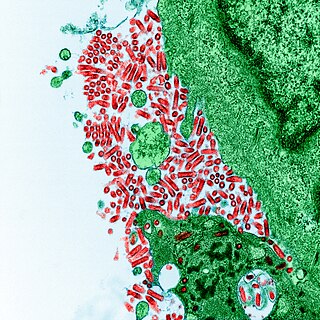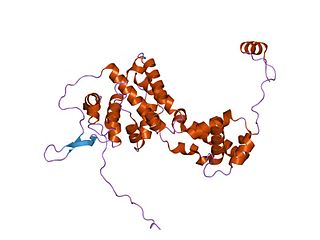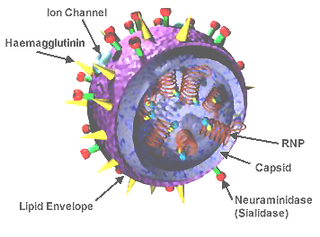
The mumps virus (MuV) is the virus that causes mumps. MuV contains a single-stranded, negative-sense genome made of ribonucleic acid (RNA). Its genome is about 15,000 nucleotides in length and contains seven genes that encode nine proteins. The genome is encased by a capsid that is in turn surrounded by a viral envelope. MuV particles, called virions, are pleomorphic in shape and vary in size from 100 to 600 nanometers in diameter. One serotype and twelve genotypes that vary in their geographic distribution are recognized. Humans are the only natural host of the mumps virus.

Measles morbillivirus(MeV), also called measles virus (MV), is a single-stranded, negative-sense, enveloped, non-segmented RNA virus of the genus Morbillivirus within the family Paramyxoviridae. It is the cause of measles. Humans are the natural hosts of the virus; no animal reservoirs are known to exist.

Rabies virus, scientific name Rabies lyssavirus, is a neurotropic virus that causes rabies in humans and animals. Rabies transmission can occur through the saliva of animals and less commonly through contact with human saliva. Rabies lyssavirus, like many rhabdoviruses, has an extremely wide host range. In the wild it has been found infecting many mammalian species, while in the laboratory it has been found that birds can be infected, as well as cell cultures from mammals, birds, reptiles and insects. Rabies is reported in more than 150 countries on all continents, with the exclusion of Antarctica. The main burden of disease is reported in Asia and Africa, but some cases have been reported also in Europe in the past 10 years, especially in returning travellers.

Membrane alanyl aminopeptidase also known as alanyl aminopeptidase (AAP) or aminopeptidase N (AP-N) is an enzyme that in humans is encoded by the ANPEP gene.

The Semliki Forest virus is an alphavirus found in central, eastern, and southern Africa. It was first isolated from mosquitoes in the Semliki Forest, Uganda by the Uganda Virus Research Institute in 1942 and described by Smithburn and Haddow. It is known to cause disease in animals including humans.
Mokola lyssavirus, commonly called Mokola virus (MOKV), is an RNA virus related to rabies virus that has been sporadically isolated from mammals across sub-Saharan Africa. The majority of isolates have come from domestic cats exhibiting symptoms characteristically associated to rabies virus infection.
Murray Valley encephalitis virus (MVEV) is a zoonotic flavivirus endemic to northern Australia and Papua New Guinea. It is the causal agent of Murray Valley encephalitis. In humans, it can cause permanent neurological disease or death. MVEV is related to Kunjin virus, which has a similar ecology, but a lower morbidity rate. Although the arbovirus is endemic to Northern Australia, it has occasionally spread to the southern states during times of heavy rainfall during the summer monsoon season via seasonal flooding of the Murray-Darling River system. These outbreaks can be "...decades apart, with no or very few cases identified in between".

Nucleoproteins are proteins conjugated with nucleic acids. Typical nucleoproteins include ribosomes, nucleosomes and viral nucleocapsid proteins.

Influenza C virus is the only species in the genus Gammainfluenzavirus, in the virus family Orthomyxoviridae, which like other influenza viruses, causes influenza.
Infectious hematopoietic necrosis virus (IHNV), is a negative-sense single-stranded, bullet-shaped RNA virus that is a member of the Rhabdoviridae family, and from the genus Novirhabdovirus. It causes the disease known as infectious hematopoietic necrosis in salmonid fish such as trout and salmon. The disease may be referred to by a number of other names such as Chinook salmon disease, Coleman disease, Columbia River sockeye disease, Cultus Lake virus disease, Oregon sockeye disease, Sacramento River Chinook disease and sockeye salmon viral disease. IHNV is commonly found in the Pacific Coast of Canada and the United States, and has also been found in Europe and Japan. The first reported epidemics of IHNV occurred in the United States at the Washington and the Oregon fish hatcheries during the 1950s. IHNV is transmitted following shedding of the virus in the feces, urine, sexual fluids, and external mucus and by direct contact or close contact with surrounding water. The virus gains entry into fish at the base of the fins.

Y box binding protein 1 also known as Y-box transcription factor or nuclease-sensitive element-binding protein 1 is a protein that in humans is encoded by the YBX1 gene.

Heat shock 70 kDa protein 6 is a protein that in humans is encoded by the HSPA6 gene.
Jembrana disease is an acute viral disease of cattle. While it produces relatively mild symptoms in taurine cattle, the Jembrana virus is particularly severe in Bali cattle where it has a fatality rate of approximately 17 percent. Its first documented outbreak occurred in 1964 in the Jembrana district of Bali, Indonesia. Within two years of its appearance the disease had killed an estimated 26,000 of the approximately 300,000 cattle on Bali Island. The Jembrana disease virus belongs to the genus Lentivirus, which include immunodeficiency viruses such as HIV. Instead of the chronic disease produced by most lentiviruses, Jembrana disease produces acute effects. After an incubation period of 5–12 days the disease produces symptoms including loss of appetite, fever, lethargy, enlargement of the lymph nodes, and diarrhea. There is at least one strain that has been sequenced.
A marker vaccine is a vaccine which allows for immunological differentiation of infected from vaccinated animals, and is also referred to as a DIVA vaccine [Differentiation of infected from vaccinated animals] in veterinary medicine. In practical terms, this is most often achieved by omitting an immunogenic antigen present in the pathogen being vaccinated against, thus creating a negative marker of vaccination. In contrast, vaccination with traditional vaccines containing the complete pathogen, either attenuated or inactivated, precludes the use of serology in epidemiological surveys in vaccinated populations.

The Borna disease viruses 1 and 2 are members of the species Mammalian 1 orthobornavirus and cause Borna disease in mammals.
Bovine immunodeficiency virus (BIV) is a retrovirus belonging to the genus Lentivirus. It is similar to the human immunodeficiency virus (HIV) and infects cattle. The cells primarily infected are lymphocytes and monocytes/macrophages.
Alphasatellites are a single-stranded DNA family of satellite viruses that depend on the presence of another virus to replicate their genomes. As such, they have minimal genomes with very low genomic redundancy. The genome is a single circular single strand DNA molecule. The first alphasatellites were described in 1999 and were associated with cotton leaf curl disease and Ageratum yellow vein disease. As begomoviruses are being characterised at the molecular level an increasing number of alphasatellites are being described.
V-cath endopeptidase is an enzyme. This enzyme catalyses the following chemical reaction

Influenza D virus is a species in the virus genus Deltainfluenzavirus, in the family Orthomyxoviridae, that causes influenza.

Adnaviria is a realm of viruses that includes archaeal viruses that have a filamentous virion and a linear, double-stranded DNA genome. The genome exists in A-form (A-DNA) and encodes a dimeric major capsid protein (MCP) that contains the SIRV2 fold, a type of alpha-helix bundle containing four helices. The virion consists of the genome encased in capsid proteins to form a helical nucleoprotein complex. For some viruses, this helix is surrounded by a lipid membrane called an envelope. Some contain an additional protein layer between the nucleoprotein helix and the envelope. Complete virions are long and thin and may be flexible or a stiff like a rod.











